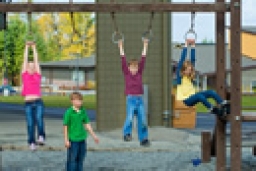Combining Aerobic and Resistance Training a Formula for Success
Thursday, October 30, 2014 - 10:00

Childhood obesity rates in Canada have been increasing over the last three decades. Establishing a healthy lifestyle for your child can help combat obesity and maintain a healthy weight. A great way to maintain a healthy weight is to eat a proper diet and implementing regular exercise.
A new study released in the Journal of American Medical Association (JAMA) Pediatrics suggests one way of combating obesity is by combining both aerobic and resistance training exercises. The study had 304 participants between the ages of 14-18 divided into 4 groups for 22 weeks: the 1st group with 75 subjects did only aerobic training, the 2nd group had 78 subjects carry out resistance training, the 3rd group combined aerobic and resistance training among 75 subjects and the 4th group was the non-exercising control group with 76 subjects. All groups had to reduce their caloric intake by 250kcal daily.
The results of the study concluded that those who did aerobic, resistance and, combined aerobic and resistance training lowered their body fat and waist circumference. Those who focused exclusively on either aerobic or strength training noted a 4cm improvement, while the combined exercise group accumulated a 7cm improvement. Those in the control group did not see any improvements.
Additional Studies show:
- Obesity is a complex issue that can be attributed to a variety of factors: genes, biology, behavior and cultural influences.
- Children between the ages of 10-13 who are obese are 80% more likely to be obese adults.
- If a household has 1 obese parent, there is a 50% likelihood that their children will also be obese. If both parents are obese, this number increases to 80%.
- Obesity can be due to consuming more calories than the amount expended.
In order to know if your child is overweight or at a healthy weight it is best to check with their pediatrician. The annual checkup can be a great time as the doctor can measure your child’s height and weight and calculate their BMI, body mass index. They can also assess their diet, amount of physical activity, waist circumference and other necessary measurements. These measurements can also be used to compare year to year differences and gauge any changes.
Exercise and proper diet are all great ways to combat obesity and promote wellness. Using research and best practices can help develop healthy eating and physical activity among children. In general, healthy children live to be healthy adults and studies such as the one mentioned above can help illuminate the path to greater health in the long term.
References from the SIRC Collection:
1. Aucouturier J, Thivel D, Duché P, et al. Combined food intake and exercise unmask different hormonal responses in lean and obese children. Applied Physiology, Nutrition & Metabolism. June 2013;38(6):638-643.
2. Farley T, Dowell D. Preventing Childhood Obesity: What Are We Doing Right?. American Journal Of Public Health. September 2014;104(9):1579-1583.
3. Gollust S, Niederdeppe J, Barry C. Framing the Consequences of Childhood Obesity to Increase Public Support for Obesity Prevention Policy. American Journal Of Public Health. November 2013;103(11):e96-e102.
4. Min-Chen W, Che-Hung L, Chia-Hua K, et al. THREE-YEAR EVOLUTION OF PHYSICAL FITNESS AND BMI IN SCHOOLCHILDREN AGED 12-16 YEARS WITH EXTREME BMI. / TROGODIŠNJI TREND PROMJENA TJELESNE PRIPREMLJENOSTI I INDEKSA TJELESNE MASE U UČENIKA U DOBI OD 12 DO 16 GODINA S EKSTREMNIM INDEKSIMA TJELESNE MASE. Kinesiology. June 2012;44(1):39-46.
5. Resistance Training for Obese Children and Adolescents. President's Council On Physical Fitness & Sports Research Digest. September 2007;8(3):1-8.
6. YoonMyung K, SoJung L. Physical activity and abdominal obesity in youth. Applied Physiology, Nutrition & Metabolism. August 2009;34(4):571-581.